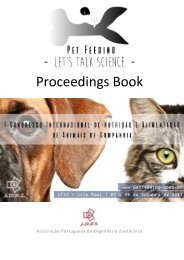Book of Proceedings I PetFeeding
Book of Proceedings I PetFeeding
Book of Proceedings I PetFeeding
Create successful ePaper yourself
Turn your PDF publications into a flip-book with our unique Google optimized e-Paper software.
37<br />
<strong>of</strong> life. Antibodies can be provided by cross-matched serum from vaccinated adult orally within<br />
24 hours, or subcutaneously thereafter, at 15 ml per kitten or 22 ml/kg for puppies, split in<br />
boluses every 12 hours (Levy, 2001). Some manufacturers add bovine or avian colostrum to<br />
the milk replacer to bridge the period until immune system maturation.<br />
Feeding –what and how much<br />
For suckling neonates, the optimum nutrition is provided by the mother <strong>of</strong> the same species<br />
who herself is consuming adequate amounts <strong>of</strong> a balanced diet fulfilling her needs. The milk<br />
replacers have to match closely the milk composition <strong>of</strong> the respective species. Complete milk<br />
analysis have been investigated for domestic cat and dog (Adkins, 1997; Jacobsen, 2004;<br />
Debraekeleer, 1998).<br />
The minimum requirements and the recommended allowances for protein and amino acids<br />
are available for puppies from 4 weeks <strong>of</strong> age (NRC). For fats, vitamins, and minerals, the NRC<br />
makes recommendations only for growing puppies > 14 weeks <strong>of</strong> age.<br />
Although, cow and goat milk are too high in lactose compared to bitch’s milk, the<br />
homemade formulas can be used in emergency until a commercial diet is acquired. Commercial<br />
diets <strong>of</strong>fer more balanced nutrition, but are still being improved by the manufacturers. A 2014<br />
study comparing 15 commercial milk replacers to nutrient concentration in 5 samples <strong>of</strong> dog<br />
milk, found that none <strong>of</strong> the milk replacers were close match to dog milk (Heinze, 2014). Out<br />
<strong>of</strong> 21 essential nutrients analyzed, 11 to 18 were outside the range for dog milk, while over half<br />
<strong>of</strong> all nutrients did not match the dog milk ranges. Out <strong>of</strong> 3 milk replacers with the closest<br />
match, excess linoleic acid, low energy density, inappropriate Ca to P ratio and no measurable<br />
DHA were <strong>of</strong> concern. The feeding instructions did not match the necessary energy intake. So,<br />
adherence to feeding directions could easily lead to substantial over- or underfeeding. The study<br />
<strong>of</strong> the milk replacers use in large breed dogs, also showed that the protein and fat content was<br />
lower than dog milk and vitamin D was threefold higher (Corbee, 2012). Nutrient deficiency<br />
can result in significant abnormalities. For example, shortages in tryptophan, niacin, or taurine<br />
lead to cataract development (Frankel, 2001; Ranz D, 2002; Lange, 2017).<br />
In other words, while commercial diets strive to match the dog milk composition and<br />
provide the feeding recommendations, the progress <strong>of</strong> each animal should be monitored closely<br />
individually and the intake adjusted accordingly. Nutritional assessment <strong>of</strong> the orphan pup and<br />
kitten is based on weight gain, physical examination, and age appropriate activity levels as there<br />
are no standardized growth charts or body condition scoring available for nursing neonates.<br />
Nutrients requirements guidelines are guidelines are limited due to limitations in available<br />
research, but various formulas available for determining neonate’s energy requirements (e.g.<br />
20-26 kcal/100g BW/day for pups and 15-25 kcal/100g BW/day for kittens).<br />
The period from birth to weaning is the time <strong>of</strong> anatomical, microbial and functional<br />
development <strong>of</strong> the feline and canine gastrointestinal tract. Sterile gastrointestinal tract is<br />
colonized right after birth and approximately 15% <strong>of</strong> foster kittens die before 8 weeks <strong>of</strong> age due<br />
to enteritis. Out <strong>of</strong> numerous infectious agents that can be the cause, the role <strong>of</strong> commensals and



